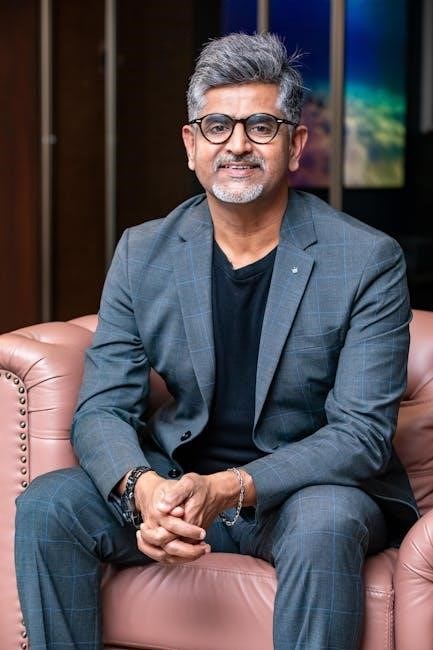The 5 Levels of Leadership‚ developed by John Maxwell‚ provide a framework for understanding and advancing leadership skills. This structured approach emphasizes growth‚ influence‚ and effectiveness‚ guiding leaders to maximize their potential while fostering strong relationships and achieving organizational success.
Understanding the Importance of Leadership Growth
Leadership growth is a journey‚ not a destination‚ and it plays a critical role in maximizing influence and effectiveness. According to John Maxwell‚ leadership is not about a position but about the ability to inspire and empower others. The 5 Levels of Leadership framework emphasizes that growth is intentional and requires continuous effort. As leaders progress through the levels‚ they build stronger relationships‚ achieve greater results‚ and develop others. Leadership growth fosters credibility‚ trust‚ and long-term success. It enables leaders to adapt to challenges‚ foster innovation‚ and create lasting impact. By prioritizing growth‚ leaders can unlock their potential and help others do the same‚ leading to a more empowered and productive team. Ultimately‚ leadership growth is essential for creating a legacy that transcends individual achievement‚ benefiting organizations and communities for the long term.

Level 1: Position
Level 1 is the foundational stage where leadership is based on title or position. People follow because they have to‚ not because they want to‚ relying on authority rather than influence.
Definition and Challenges of Entry-Level Leadership
Level 1‚ or Position‚ is the most basic stage of leadership‚ where authority is derived from a title or role. At this stage‚ leaders rely on their position to influence others‚ as they have not yet built personal credibility or relationships. People follow because they feel they have to‚ not because they want to. This level is challenging because it lacks the personal connection and trust that higher levels of leadership require. Leaders at this stage often struggle to inspire or motivate beyond compliance‚ especially when working with volunteers or in situations where formal authority holds little sway. However‚ this level serves as a foundation for growth‚ allowing leaders to develop self-discipline‚ prioritize tasks‚ and prepare for the next stage of leadership development. Without mastering this initial step‚ moving to higher levels becomes difficult.

Level 2: Permission
At this stage‚ leaders earn the right to lead by building relationships and trust. People follow because they want to‚ not just because they have to. This level focuses on connection‚ likability‚ and mutual respect.
Building Relationships and Trust
Trust is the cornerstone of Level 2 leadership‚ where relationships are nurtured through genuine connection and empathy. Leaders at this stage focus on understanding their team members’ strengths‚ weaknesses‚ and aspirations‚ fostering a sense of value and belonging. By being approachable‚ consistent‚ and reliable‚ leaders build credibility and earn the trust of their followers. This level emphasizes the importance of likability‚ as people are more inclined to follow leaders they respect and enjoy working with. Trust becomes the glue that strengthens relationships‚ enabling collaboration and mutual growth. As leaders invest time in their people‚ they create a culture of openness and support‚ laying a solid foundation for the next levels of leadership development. This stage is where leadership transitions from authority to influence‚ making it a critical step in the journey to becoming a more effective and respected leader.

Level 3: Production
Leaders at this level focus on achieving results‚ building credibility‚ and becoming change agents. They inspire productivity‚ improve morale‚ and lead by example‚ driving organizational success and team cohesion effectively.

Achieving Results and Credibility
At Level 3: Production‚ leaders establish credibility by delivering consistent results. This stage is about proving oneself as a reliable and effective leader who can drive progress and overcome challenges. By achieving tangible outcomes‚ leaders gain the trust and respect of their teams‚ fostering a culture of accountability and high performance. Momentum becomes a key ally‚ as successful outcomes breed confidence and motivation among team members. Effective Level 3 leaders are adept at solving problems‚ improving processes‚ and maintaining a forward-focused mindset. Their ability to produce results not only strengthens their influence but also positions them as indispensable assets to the organization. This level is where leadership transitions from relationship-building to demonstrating measurable impact‚ laying the groundwork for more advanced levels of influence and development.

Level 4: People Development
Level 4 focuses on investing in others‚ developing their leadership potential‚ and reproducing capable leaders. This stage emphasizes mentoring and empowering individuals to grow‚ ensuring a lasting impact on the organization.
Investing in the Growth of Others
At Level 4: People Development‚ leaders focus on nurturing and empowering others to reach their full potential. This stage is about intentional mentorship‚ where leaders invest time and effort into developing their team members’ skills and confidence. By fostering a culture of growth‚ leaders create a ripple effect‚ as those they mentor become capable of leading others. This level requires patience‚ consistency‚ and a genuine commitment to the success of others. Leaders at this stage understand that their legacy is built not just by what they achieve but by who they develop. The goal is to reproduce leaders who can‚ in turn‚ develop others‚ ensuring the organization’s continued success and impact.

Level 5: Pinnacle
Level 5: Pinnacle is the highest and most challenging level of leadership‚ requiring longevity‚ talent‚ and a deep commitment to developing others. Leaders at this stage create lasting legacies‚ inspiring others beyond their organization‚ and leaving a profound impact on their industry and community. Their influence transcends their role‚ earning respect and trust on a broader scale. This level is reserved for those who consistently invest in others and achieve extraordinary results‚ fostering a culture of excellence and sustainability. Reaching the Pinnacle is a testament to dedication‚ vision‚ and the ability to empower future leaders.
Attaining the Highest Level of Leadership
Reaching Level 5: Pinnacle is the ultimate achievement in leadership‚ requiring a rare combination of talent‚ dedication‚ and longevity. Leaders at this stage have invested years in mastering previous levels‚ building strong relationships‚ delivering results‚ and developing others; They are recognized for their exceptional ability to inspire and influence beyond their immediate organization‚ often creating a lasting legacy. Level 5 leaders are visionary‚ consistently producing high-impact results and fostering a culture of excellence. Their influence extends beyond their role‚ earning them widespread respect and admiration. To attain this level‚ leaders must demonstrate unwavering commitment to personal growth‚ a passion for mentoring others‚ and a willingness to serve the greater good. The Pinnacle is not just a destination but a continuous journey of empowering others and leaving a profound impact on the world.
The 5 Levels of Leadership framework by John Maxwell provides a clear path for leaders to grow‚ inspire‚ and make a lasting impact. Emphasizing personal growth‚ relationships‚ results‚ and legacy‚ this model guides leaders to reach their full potential and leave a meaningful influence on others and their organizations.
Summarizing the Journey Through the 5 Levels
The 5 Levels of Leadership framework by John Maxwell offers a comprehensive guide to leadership development‚ emphasizing growth‚ influence‚ and legacy. Starting with Position‚ where authority is granted by title‚ leaders progress to Permission‚ building trust and relationships. At Production‚ credibility is earned through results‚ while People Development focuses on empowering others to lead. The pinnacle‚ Pinnacle‚ is achieved by leaving a lasting impact and legacy. Each level builds on the previous one‚ requiring intentionality‚ effort‚ and a commitment to continuous improvement. The journey highlights that leadership is not static but a dynamic process of personal and organizational growth. By understanding and mastering these levels‚ leaders can maximize their potential‚ inspire others‚ and create a lasting influence. This framework serves as a roadmap for leaders at any stage to evaluate their progress and strive for higher levels of effectiveness and impact.

No Responses